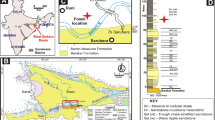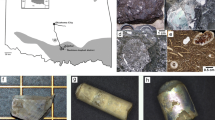Abstract
The laminated, bituminous sediments of the upper Oligocene (Chattian, MP 28) volcanic crater Lake Enspel preserve a large variety of fossils of the former flora and fauna of the lake and its surroundings. By means of FE-SEM techniques, we have identified the remains of globally rare Cenozoic testate amoebae (Amoebozoa: Thecamoeba) associated with gemmules of freshwater sponges. This is the first record of siliceous shell plates of Scutiglypha sp., an euglyphid testate amoebae from Lake Enspel. The existence of an intermittently swampy and/or near shore habitat of Lake Enspel is discussed.





Similar content being viewed by others
References
Adl, S. M., et al. (2005). The new higher level classification of Eukaryotes with emphasis on taxonomy of protists. Journal of Eukaryotic Microbiology, 52(5), 399–451.
Adl, S. M., et al. (2012). The revised classification of Eukaryotes. Journal of Eukaryotic Microbiology, 59(5), 429–493.
Barber, A., Siver, P. A., & Karis, W. (2013). Euglyphid testate amoebae (Rhizaria: Euglyphida) from an arctic Eocene waterbody: evidence of evolutionary stasis in plate morphology for over 40 million years. Protist, 164, 541–555.
Bellon, H., Büzekm, Č., Gaudant, J., Kvacek, Z., & Walther, H. (1998). The Česke středohoři magmatic complex in northern Bohemia 40K-40Ar ages for volcanism and biostratigraphy of the Cenozoic freshwater formations. Newsletters on Stratigraphy, 36, 77–103.
Cavalier-Smith, T. (2002). The phagotrophic origin of eukaryotes and phylogenetic classification of Protozoa. International Journal of Systematic and Evolutionary Microbiology, 52(2), 297–354.
Clausing, A. (2001). Primärproduktion und Laminationsbildung ausgewählter lakustriner Environments im Tertiär und Permokarbon Deutschlands. Hallesches Jahrbuch für Geowissenschaften, Reihe B, Beiheft, 14, 1–183.
De Smet, W. H., & Gibson, J. A. E. (2009). On a new species of euglyphid testate amoeba, Scutiglypha cabrolae, from the Licancabur Caldera Lake, Central Andes. Acta Protozoologica, 48, 119–126.
Escobar, J. (2005). The thecamoebians as environmental and palaeoenvironmental indicators: evidence from modern thecamoebian distributions in Florida. http://etd.fcla.edu/UF/UFE0010280/escobar_j.pdf. Accessed 25 February 2015.
Farooqui, A., Kumar, A., & Swindles, G. T. (2012). Thecamoebian communities as proxies of seasonality in Lake Sadatal in the Ganga-Yamuna Plains of North India. Palaeontologia Electronica, 15(1), 3A, 1–19.
Felder, M., Weidenfeller, M., & Wuttke, M. (1998). Lithologische Beschreibung einer Forschungsbohrung im Zentrum des oberoligozänen, vulkano-lakustrinen Beckens von Enspel/Westerwald (Rheinland-Pfalz, Bundesrepublik Deutschland). Mainzer Geowissenschaftliche Mitteilungen, 27, 101–136.
Foissner, W., & Schiller, W. (2001). Stable for 15 million years: scanning electron microscope investigation of Miocene euglyphid thecamoebians from Germany, with description of the new genus Scutiglypha. European Journal of Protistology, 37, 167–180.
Gaupp, R., & Wilke, A. (1998). Zur Sedimentologie der oberoligozänen Seesedimente von Enspel/Westerwald. Hallesches Jahrbuch für Geowissenschaften, Beiheft, B20, 97–118.
Herrmann, M. (2010). Palaeoecological reconstruction of the late Oligocene Maar Lake of Enspel, Germany using lacustrine organic walled algae. Palaeobiodiversity and Palaeoenvironments, 90, 29–37.
Hottenrott, M. (1988). Palynologie, Stratigraphie und Paläogeographie im Tertiär von Mittelhessen und Umgebung. Geologisches Jahrbuch Hessen, 116, 113–168.
Kastner, M., Keene, J. B., & Gieskes, J. M. (1977). Diagenesis of siliceous oozes – I. Chemical controls on the rate of opal-A to opal-CT transformation – an experimental study. Geochimica et Cosmochimica Acta, 41, 1041–1059.
Kim, S., Soltis, D. E., Soltis, P. S., & Suh, Y. (2004). DNA sequences from Miocene fossils: an ndhF sequence of Magnolia latahensis (Magnoliaceae) and an rbcL sequence of Persea pseudocarolinensis (Lauraceae). American Journal of Botany, 91(4), 615–620.
Köhler, J., & Clausing, A. (2000). Taxonomy and palaeoecology of dinoflagellate cysts from Upper Oligocene freshwater sediments of Lake Enspel, Westerwald area, Germany. Review of Palaeobotany and Palynology, 112, 39–49.
Martini, E., & Rothe, P. (2005). Die Fossillagerstätte Sieblos an der Wasserkuppe/Rhön – Neue Daten zur Genese, zum Alter und zur Fossilführung. Geologisches Jahrbuch Hessen, 132, 55–68.
Mertz, D. F., Swisher, C. C., Franzen, J. L., Neuffer, F. O., & Lutz, H. (2000). Numerical dating of the Eckfeld maar fossil site, Eifel, Germany: a calibration mark for the Eocene time scale. Naturwissenschaften, 87, 270–274.
Mertz, D. F., Renne, P. R., Wuttke, M., & Mödden, C. (2007). A numerically calibrated reference level (MP28) for the terrestrial mammal-based biozonation of the European Upper Oligocene. International Journal of Earth Sciences (Geologische Rundschau), 96, 353–361.
Ogden, C. G. (1990). The structure of the shell wall in testate amoebae and the importance of the organic cement matrix. In: Claugher D. (ed) Scanning electron microscopy in taxonomy and functional morphology. Systematics Association Special Volume, 41, 235–257.
Pirrung, B. M. (1998). Zur Entstehung isolierter alttertiärer Seesedimente in zentraleuropäischen Vulkanfeldern. Mainzer Naturwissenschaftliches Archiv Beihefte, 20, 1–117.
Pirrung, M., Büchel, G., & Jakoby, W. (2001). The Tertiary volcanic basins of Eckfeld, Enspel and Messel (Germany). Zeitschrift der Deutschen Geologischen Gesellschaft, 152, 27–59.
Schäfer, P., Schindler, T., Hottenrott, M., & Wuttke, M. (2011). Westerwald. In: Deutsche Stratigraphische Kommission (ed) Stratigraphie von Deutschland IX – Tertiär, Teil 1: Oberrheingraben und benachbarte Tertiärgebiete. Schriftenreihe der Deutschen Geologischen Gesellschaft, 75, 355–375.
Schiller, W. (1997). Kieselige Thekamöben aus der miozänen Kieselgur von Beuern/Vogelsberg im Vergleich mit rezentem Material von Borneo (Malaysia). Courier Forschungsinstitut Senckenberg, 201, 385–392.
Schiller, W. (1998). Kieselige Mikrofossilien aus dem Unter-Oligozän von Sieblos/Rhön. Geologische Abhandlungen Hessen, 104, 173–199.
Schiller, W. (1999). Kieselige Thekamöben aus dem Mittel-Eozän des Eckfelder Maares in der Eifel. Mainzer Naturwissenchaftliches Archiv, 37, 55–62.
Schiller, W. (2000a). Feinstratigraphische Untersuchungen der Kernbohrung Enspel 1991(2) unter besonderer Berücksichtigung der kieseligen Mikrofossilien. Mainzer Naturwissenchaftliches Archiv, 38, 39–91.
Schiller, W. (2000b). Miocene kieselgur from Beuern/Vogelsberg – a deposit of a volcanic crater lake. Terra Nostra, 2000(6), 460–464.
Schiller, W. (2007). Siliceous microfossils from the Oligocene Tripoli-deposit of Seifhennersdorf. Acta Musei Nationalis Pragae, Serie B, Historia Naturalis, 63(2–4), 195–204.
Schindler, T., & Wuttke, M. (2010). Geology and limnology of the Enspel Formation (Chattian, Oligocene; Westerwald, Germany). In: M. Wuttke, D. Uhl, T. Schindler (eds) Fossil-Lagerstätte Enspel - exceptional preservation in an Upper Oligocene maar. Palaeobiodiversity and Palaeoenvironments, 90, 21–27.
Schindler, T., & Wuttke, M. (2015). A revised sedimentological model for the Late Oligocene Lake Enspel (Enspel Formation, Westerwald Mountains, Germany). In: M. Wuttke, T. Schindler, K.T. Smith (eds) The Fossil-Lagerstätte Enspel – reconstructing the palaeoenvironment with new data on fossils and geology. Palaeobiodiversity and Palaeoenvironments, 95, 5–16.
Schmidt, A. R., Schönborn, W., & Schäfer, U. (2004). Diverse fossil amoebae in German Mesozoic amber. Palaeontology, 47, 185–197.
Siver, P. A., & Wolfe, A. P. (2005). Scaled chrysophytes in Middle Eocene lake sediments from Northwestern Canada, including descriptions of six new species. Nova Hedwigia. Beiheft, 128, 295–308.
Vincent, G. (2012). Fossil amoebae (Hemiarcherellidae fam. nov.) from Albian (Cretaceous) amber of France. Palaeontology, 55, 653–659.
Von Rad, U., Riech, V., & Rösch, H. (1978). Silica diagenesis in continental margin sediments off northwest Africa. Initial Reports of the Deep Sea Drilling Project, XLI, 879–905.
Williams, J. L. (1985). Thecamoebian scales from a Miocene lacustrine deposit in Northern Idaho. In C. J. Smiley (Ed.), Late Cenozoic history of the Pacific northwest (pp. 67–71). San Francisco: American Association for the Advancement of Science, Memoir of the California Academy of Sciences.
Wolfe, A. P., Edlund, M. B., Sweet, A. R., & Creighton, S. (2006). A first account of organelle preservation in Eocene nonmarine diatoms: observations and paleobiological implications. Palaios, 21, 298–304.
Acknowledgements
We thank Markus Poschmann (Mainz) for his supply and selection of well-preserved gemmule-bearing sediment samples from the excavation campaigns at Enspel. Prof. J. Herrle (IfG, Goethe University Frankfurt) kindly provided access to the FE-SEM Zeiss Sigma Gemini for our investigations. We also thank Prof. B. Reichenbacher (LMU Munich) and two anonymous reviewers for valuable remarks which improved the manuscript. Last but not least we want to thank Dr. K. Smith for improving the English and Dr. P. Königshof and Dr. S. Weber (all Senckenberg, Frankfurt) for managing the editing process of the Special Issue “The Fossil-Lagerstätte Enspel – reconstructing the palaeoenvironments with new data on fossils and geology”. Palaeobiodiversity and Palaeoenvironments, 95 (1).
Author information
Authors and Affiliations
Corresponding author
Additional information
This article is an additional contribution to the special issue “The Fossil-Lagerstätte Enspel - reconstructing the palaeoenvironment with new data on fossils and geology”.
Rights and permissions
About this article
Cite this article
Schiller, W., Wuttke, M. First record of siliceous shell plates of Scutiglypha sp. (Amoebozoa: Thecamoeba: Euglyphidae) from Lake Enspel (upper Oligocene, Westerwald Mountains, Germany). Palaeobio Palaeoenv 95, 513–519 (2015). https://doi.org/10.1007/s12549-015-0211-2
Received:
Revised:
Accepted:
Published:
Issue Date:
DOI: https://doi.org/10.1007/s12549-015-0211-2




